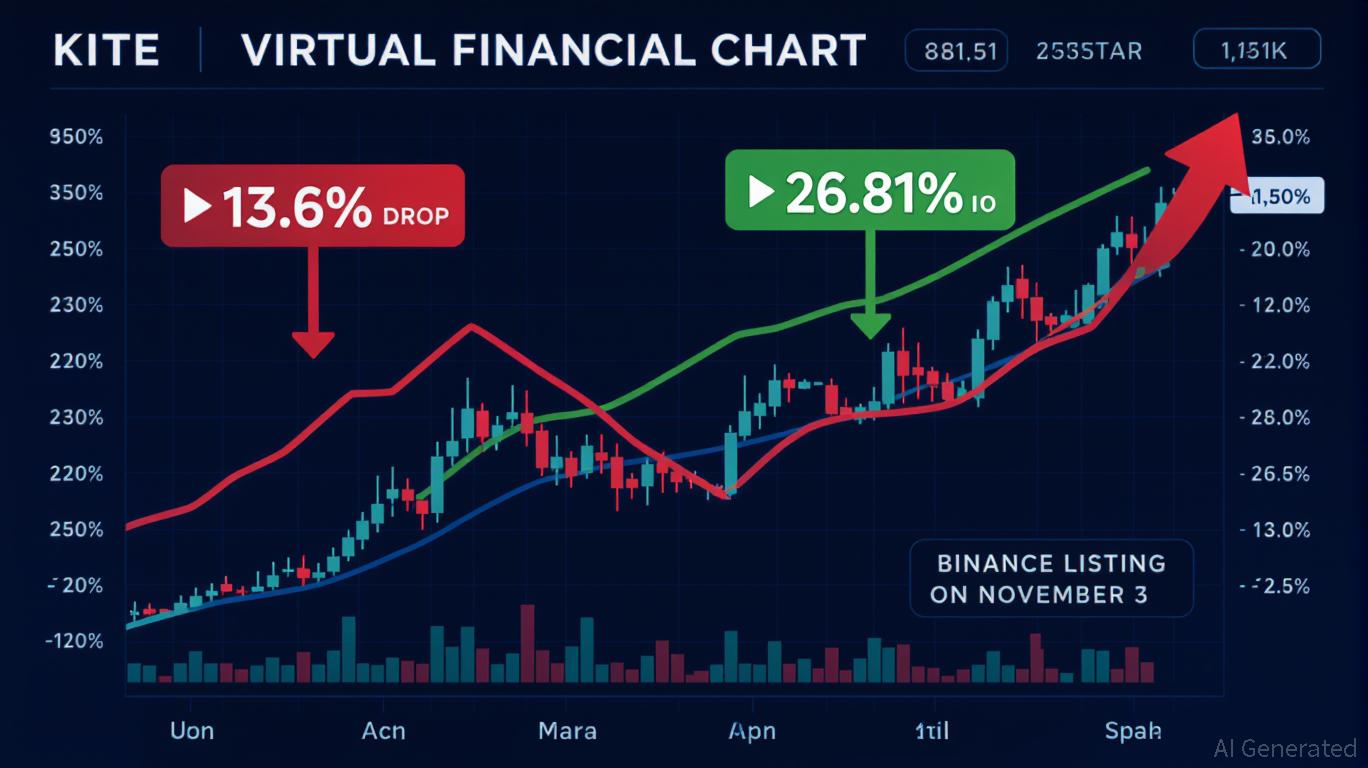Kite (KITE) Price Forecast and Market Sentiment After Listing: Managing Fluctuations and Assessing Institutional Interest
- Kite (KITE) launched on Binance on November 3, 2025, opening at $0.11 before dropping 13.6% to $0.095, highlighting post-listing volatility. - Short-term price swings were driven by institutional interest in BingX's Xpool staking and leveraged trading up to 50x, per CoinMarketCap analysis. - Long-term potential emerges through BingX's structured staking and U.S. crypto ETF approvals, which could normalize KITE as an AI-focused asset class. - The token's $929M FDV and SPACE Framework's AI agent infrastruc
Short-Term Volatility: Opportunity and Risk
Immediately after KITE's listing, the market displayed a classic "buy the rumor, sell the news" pattern. The token's integration with BingX's Xpool—a staking platform where users could earn KITE points later exchangeable for tokens—attracted early institutional attention, but
This instability is further heightened by KITE's early development stage. Unlike more established digital assets, KITE's value is tied to its SPACE Framework—a blockchain built for AI agents—but its practical adoption is still untested. As one observer put it, "AI remains a hot topic, but whether KITE can deliver real-world applications will determine if it’s just another trend or a foundational asset," as referenced in the CoinMarketCap analysis.

Long-Term Institutional Adoption: The Road Ahead
Despite recent price swings, KITE is gaining momentum among institutional players. BingX's Xpool program, which lets both institutional and retail participants stake assets like
Wider industry trends also support KITE’s institutional prospects. The anticipated approval of U.S. spot crypto ETFs, following the resolution of the recent government shutdown, could pave the way for a surge of institutional investment in digital assets, as discussed in
Strategic or Speculative? Assessing the Stakes
The discussion around KITE’s long-term value versus its speculative appeal centers on two main factors: its technological uniqueness and its ability to attract institutional support. The SPACE Framework’s emphasis on AI agents—a field expected to expand rapidly—positions KITE as a possible backbone for the next era of digital innovation, according to CoinMarketCap. At the same time, the token’s $929 million FDV points to considerable growth potential if adoption increases, but also highlights the gap between current market value and future promise.
For investors focused on crypto, whether to include KITE in their portfolios depends on their risk appetite. Traders may seek to profit from its volatility using leveraged products, while those with a strategic mindset may focus on its institutional partnerships and AI-driven narrative. As one analyst observed, "KITE offers both high risk and high reward. The challenge is to separate hype from genuine progress as the project develops," as mentioned in the CoinMarketCap analysis.
Conclusion: Navigating Uncertainty
Kite (KITE) encapsulates the dual nature of today’s crypto landscape: a highly volatile, speculative asset that could also become a key player in the AI economy. While its recent price swings and leveraged trading highlight immediate risks, its growing institutional adoption through BingX and alignment with AI trends provide a strong case for its long-term potential. Investors must weigh the prospects of quick profits against the uncertainties inherent in a new technology.
At present, KITE stands at a crossroads—one side marked by speculative trading, the other by the promise of institutional recognition.
Disclaimer: The content of this article solely reflects the author's opinion and does not represent the platform in any capacity. This article is not intended to serve as a reference for making investment decisions.
You may also like
Top 5 Cryptos Soaring as U.S. Government Shutdown Ends
Zcash (ZEC) Rises Sharply: Is This the Dawn of Privacy-Focused Cryptocurrency?
- Zcash (ZEC) surged 425% in 2025, trading at $528.95 as of November 6, driven by whale activity, DeFi integration (e.g., zenZEC), and rising privacy demand. - Regulatory challenges loom, with EU rules banning privacy coins by 2027 and U.S. enforcement actions targeting unlicensed privacy tools, complicating ZEC's compliance. - ZEC's hybrid model (transparent/shielded transactions) and institutional interest (e.g., BitMEX co-founder's portfolio) suggest potential for niche adoption amid regulatory tensions
Zcash Halving and Its Impact on the Market: Deflationary Features of Blockchain and Speculative Behavior of Investors
- Zcash's 2025 halving reduces block rewards by 50%, tightening supply and mirroring Bitcoin's deflationary model. - Historical data shows 500%+ price surges post-halving, with Grayscale's $137M Zcash Trust signaling institutional interest. - Privacy-focused shielded transactions (28% of supply) decouple demand from speculation, enhancing long-term utility. - Speculative FOMO drives ZEC's 1,172% YTD surge, while inverse Bitcoin dynamics attract investors during crypto downturns. - Risks include regulatory

Zcash (ZEC) Price Rally: Essential Insights for Privacy Coin Investors
- Zcash (ZEC) surged 472% in late 2025 to $420, driven by institutional adoption and privacy-focused innovation. - Grayscale invested $137M in ZEC via ZCSH, leveraging its optional transparency model to navigate AML regulations. - U.S. Clarity/Genius Acts provided legal clarity for privacy coins, while Zenrock’s zenZEC bridged privacy and DeFi. - Zcash’s 150% QoQ on-chain growth and institutional endorsements position it as a privacy-first alternative to Bitcoin . - Regulatory risks persist, but Zcash’s hy
